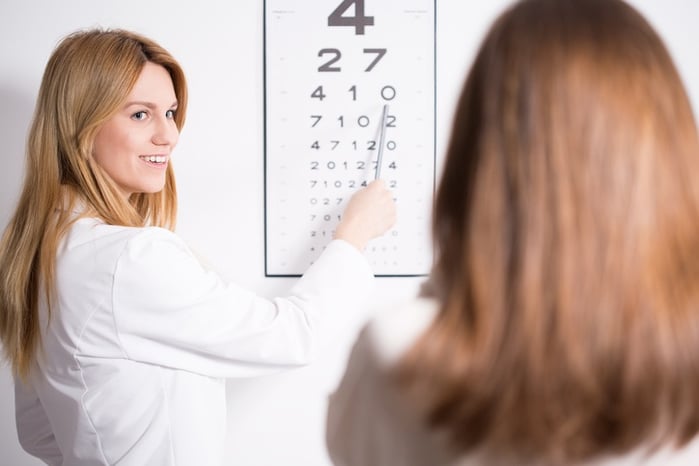Missouri Marketing Resource Blog

Understanding the Buyers Journey for Eye Patients
 Marketing to eye patients can have its challenges. Patients can be bombarded by advertisements from many channels daily, but at the same time, it’s important for your eye clinic to advertise your services to stay top of mind and be found when eye care is needed. The key to successful eye care marketing is understanding the buyer’s journey, more specifically, the buyer’s funnel for eye patients. This is a snapshot of how the buyer experiences your brand as they go through the process of making a purchase decision. Below, we’ll take a closer look at what the buyer’s funnel is and what it means for your marketing practices.
Marketing to eye patients can have its challenges. Patients can be bombarded by advertisements from many channels daily, but at the same time, it’s important for your eye clinic to advertise your services to stay top of mind and be found when eye care is needed. The key to successful eye care marketing is understanding the buyer’s journey, more specifically, the buyer’s funnel for eye patients. This is a snapshot of how the buyer experiences your brand as they go through the process of making a purchase decision. Below, we’ll take a closer look at what the buyer’s funnel is and what it means for your marketing practices.
Stages of the Buying Funnel
It’s important to understand that the buyer’s funnel is an examination of the way patients experience your practice from before they’ve even realized there’s a problem, to their actual appointment, and even post-appointment. While the processes you use to market to, engage with, and ultimately care for your patients are important to see in connection to the funnel, these should always be viewed in the context of the patient’s experience instead of the other way around. This will help you find the places where the experience breaks down and allow you to improve the relationship you build with them.
The funnel itself is composed of five separate stages that represent patients’ needs, questions, and goals:
- Unawareness: The patient either doesn’t have a problem yet or doesn’t realize they have a problem. Depending on the services you offer, this can be a good stage to present educational information that can help patients to the next stage.
- Awareness: The patient has realized they have a particular need, problem, or desire. Some of the things you should consider include how customers describe their problem, what the consequences of inaction could be, and how customers prioritize their needs.
- Comprehension: The patient does research into their need, problem, or desire. This can include learning more about their problem, discovering various solutions to that problem, and investigating potential businesses that offer the solutions they’re interested in. You should consider the channels patients are using to do research, how patients define the pros and cons of each solution, as well as the criteria that help them ultimately choose a particular solution and brand (e.g., price, distance, insurance coverage).
- Conviction: The patient decides on a solution and a business that will provide it. Consider what patients will prefer about your brand, who needs to be involved in the decision, what expectations patients will have about your product or service, and what (if any) preparations patients will need to complete before receiving service.
- Action: The patient follows through on their choice and makes a purchase.
Example Buying Funnel for Eye Patients
Unawareness
The patient doesn’t have a problem with their vision or doesn’t realize that they might have a problem with their eyes. This is a good stage to target with educational and helpful information (e.g., blog posts about vitamins and supplements that support eye health).
Awareness
Something happens to make the patient aware of their problem. This may be as simple as experiencing symptoms like eye strain, blurry vision, or chronic headache. However, sometimes this can occur when you put educational information in front of them that informs them of a problem, then they realize they have that problem. As an example, consider a patient with chronic dry eye. They may not realize that this is a medical issue they can get help with until they hear something like Jennifer Anniston’s “Eye Love” commercial. Marketing the type of information that positions you strongly in this stage can help you become a top, trusted choice for patients when it comes time to make their decision.
Comprehension
Patients will do research on their problem and internally debate which options best suits their needs as well as discuss with those close to them. They’ll seek out information that will help explain their situation as well as ask friends and family members for referrals. Remember that they’re also likely to seek online reviews; 84% of people trust these reviews as much as referrals from someone they know in person. Chances are good they’ll also peruse social media and visit brand sites, so content marketing is just as important as traditional advertising. To carry our last example forward, the patient will probably look into the symptoms and long-term effects of chronic dry eye, potentially consider natural options as well as both prescription and OTC options, visit Yelp and branded Facebook Pages, and look at brand websites. For brands that have captured consumer attention in the last stage, they’ll have a leg up here: patients who heard the “Eye Love” commercial are more likely to visit that brand’s site.
Conviction
The patient makes their decision. From our example, understanding the customer that chooses a particular OTC option is just as important as understanding the customer that decides on prescription eye drops and makes an appointment with an ophthalmologist. Why did they make that decision, and what could you have done to capture their business?
Action
The patient acts on their decision in the last stage. For the patient that chose the OTC eye drops, they’ll head to their pharmacy of choice and make a purchase. For the patient that chose the prescription option, they’ll attend their appointment, receive their prescription, and take it to their pharmacy of choice to be filled. It’s important to remember that in many cases, this part of the buyer’s funnel will also include how patients feel about their treatment, whether they’re willing to make a referral, and if they’ll choose to leave an online review. You don’t want to abandon the patient at this point, as you could very well impact their decision to choose you again or impact the way they influence others.
Takeaways
Hopefully, this examination of the buyer’s funnel has spotlighted ways to strengthen your marketing to eye patients. For instance, you can make it easier for patients to decide to go to your practice for help by providing educational content to keep your business at the top of their minds even before the decision process starts. Additionally, it helps you ensure that your practice is where your patients are, i.e., that your marketing and advertising is distributed on the right channels to reach them with your message.
When developing your eye care marketing strategy, it’s important that you keep the buyer’s funnel for eye patients in mind. It will ensure that you develop marketing outreach and touch points at every stage of the funnel, which in turn will ensure that your brand is there when your patients look for related information. Don’t forget that Zimmer is here to deliver your message to your target patients, and you can contact us for assistance, ideas, and clarifications any time. Learn more about the Buying Funnel with our free download.

